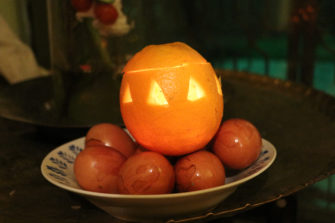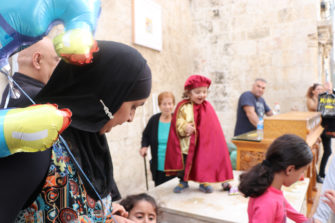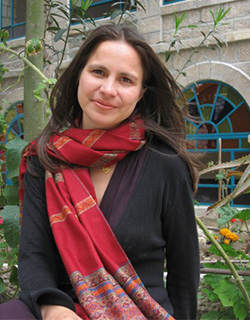
Last Easter I set out to explore some of the holiday traditions that are in danger of disappearing in the Old City of Jerusalem, where the local Christian population has been declining so rapidly that it is now estimated to be only around two percent of the city’s total population. Not knowing where to start, I approached someone whom I knew from experience would able to enlighten me: my neighbor of seven years, Mazen Ahram, a Muslim Sheikh and Islamic scholar.
While to someone unfamiliar with Jerusalem it might seem counter-intuitive to ask a Muslim leader for information about Easter, this would not be surprising at all for many old Jerusalemites. Sheikh Mazen’s family traces its lineage to the Prophet Mohammed, and arrived in Jerusalem along with Omar ibn Khattab in the 7th century when Muslims first took control of the city from the Byzantine Empire. As a result, his family had been in contact with the Christians of Jerusalem for more than 13 centuries, passing the stories of those encounters down from generation to generation.
I found Sheikh Mazen Ahram sitting behind the counter of his small shop in East Jerusalem, where he works when he is not at the al-Aqsa Mosque. My question sent him into a long, nostalgic trip to his childhood living outside of the walls of the Old City in the early 1950s. Every year, he and his Christian neighbors dyed Easter eggs together using the peelings of red onions, which naturally colored the eggs. His grandmother was well known for her skill in painting eggs, and she had a collection of painted, blown out eggs on her shelf.
Even I was surprised at how central the Christian Easter holiday was to his childhood as a devout Muslim. The local tradition states that after Muslim armies conquered Jerusalem, Omar ibn Khattab refused to pray inside the city’s main church, insisting that his followers would want to turn it into a mosque if they saw him pray there. He prayed just across from it instead, and today the Mosque of Omar stands across from the Holy Sepulcher commemorating the gesture. Local Palestinians know that two Muslim families keep the keys to the Church of the Holy Sepulcher, where tradition holds that Jesus was crucified, buried, and raised from the dead—those families are still entrusted with opening and closing the church daily.
Sheikh Mazen told me that when he was a boy, every Holy Saturday he went to the Church of the Holy Sepulcher to wait for the Holy Fire to appear. The tradition among Orthodox Christians in Jerusalem says that a holy fire was lit at the moment of Jesus’ resurrection inside of the tomb each year, and thousands would wait with candles for the flame to emerge from the tomb and to be passed around. As a boy, Mazen couldn’t afford a fancy lantern, and so he would carve out the peeling of a thick Jericho orange, place a candle inside, and wait for the flame. He then carried the fire from the holy tomb back home.

I took notes. That Holy Saturday, I waited for the Holy Fire like thousands of other Christians, and when it arrived I placed it in a candle inside of the rind of an orange. Sheikh Mazen was right; it worked like a charm. Our eggs that year were painted with onion peels.
I tell these stories because the disappearance of Christian communities in the Middle East, long warned of by local Christians, has become a startling reality. Iraq has lost two thirds of its Christian population since 2003. An estimated one third of Syrian Christians have fled during the country’s civil war, though possibly more. Those outside of the region may view the discussion as alarmist; those in the region, who saw ancient communities of Jews almost entirely vanish from the fabric of life in countries such as Iraq, Syria, and Lebanon in the last decades, know that it is entirely possible for a community to be there and then to be gone.
Yet most discussions of this crisis focus on what this means for Christians. This is understandable; as the community that is leaving, they are obviously the most heavily impacted. Nonetheless, over more than a decade of living in the Middle East, I have noticed how much the disappearance of Christians also impacts many Muslims I know in the region. During Christmas, a Muslim friend commented on Facebook about how much he missed seeing Christmas decorations in Jerusalem in the way he had when he was a child. I recently interviewed a Syrian refugee named Mouiad from the city of Daraa, who spoke of the relationship with Christians that he had before the war, when they would often fast for one another’s holidays. He often visited Christian shrines to Mary with his friends, a practice that was not uncommon. Though he had brought very little with him when he fled to Jordan, he wanted to show me one thing he had: a copy of the Bible in Arabic, kept on his shelf alongside the Quran.
Still, rarely have I come upon a public discussion of what the migration of Christians from the Middle East will mean for the Muslim communities who have lived with them for centuries. Many of these communities have based their identities on what it means to be people of faith living within pluralistic societies, and how they live with Christians has become an integral part of who they are as Muslims. Perhaps we need to talk about the Middle East in the same ways in which we talk about fragile ecosystems. When a plant or an animal disappears, we take it for granted that the entire ecosystem around it will be impacted. Living species come to depend upon one another over time; the disappearance of one can devastate another.
We often forget that human communities form the same deep relationships over centuries, and that what impacts one community cannot be discussed in isolation. This seems to me to be particularly true of Palestinian Muslims and Christians. This summer, two Israeli policemen were shot and killed by two Palestinian citizens of Israel at the entrance to the al-Aqsa Mosque/Temple Mount. Israel installed metal detectors as a response, setting off large scale demonstrations by Palestinians who argued that Israel was disrupting the status quo over who has authority over religious sites in the Old City of Jerusalem. Palestinians prayed in the streets, refusing to enter the mosque compound as long as metal detectors were in place.
While thousands prayed in the streets that week, it was one photo that was shared repeatedly by Palestinians on Facebook. It was a photo of a Nidal Aboud, a Palestinian Christian who joined the line of prayer, a cross visibly around his neck, and read from his bible as those Muslims around him prayed.
For Palestinian Muslims, sharing that photo was a way for them to express their belief that Palestinians were protesting not due to religious but political objections, and that the issue of status quo was one that concerned all Palestinians, not only Muslims. Though the Palestinian Christian was only one among thousands, he became an essential part of how Muslims told the story of that historical moment.
In the past, there have been many examples of Palestinian Christians serving as an integral part of the telling of Palestinian history, be it literary critic Edward Said, or the prominent politician Hanan Ashrawi. Even today, at a moment in which Christians are fleeing from the Middle East in historic numbers, a Palestinian named Yacoub Shaheen, the son of a Syrian Orthodox Christian carpenter from Bethlehem, won the hugely popular singing competition Arab Idol in 2017, by a landslide. He celebrated by singing a Palestinian nationalistic song; it was not long before he began advocating for Palestinian hunger strikers in prison. He makes a point of sending holiday greetings to Muslims on his social media.

On a more personal level, Sheikh Mazen told me how much the disappearance of Christians in Jerusalem has pained him, taking the time to mention every former neighbor by name. He has never forgotten the 1967 war, when his father’s tailor shop was located on the front line of the fighting between Israel and Jordan. Fearing he would lose everything, his father stored all of his sewing machines and inventory in the nearby Franciscan convent of the White Sisters for the duration of the fighting. Everything survived: he credits the nuns with saving his family’s livelihood.
What do these small holiday greetings mean, or these stories of candles lit and feast days shared, of holy books carried out of war and a single man who prays among thousands, in the larger scheme of things? As not only Christians, but other minorities disappear from the Middle East, how will it affect the world left behind, which will increasingly lose its diversity? How will the loss of these deep, if sometimes fraught relationships between faiths also affect those who leave?
That remains to be seen. But perhaps it is time to widen the conversation.

